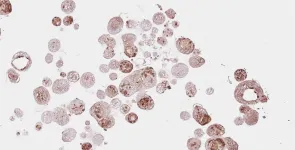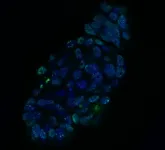(Press-News.org) Researchers from the Organoid group (Hubrecht Institute) and UMC Utrecht have developed a biobank with organoids derived from patients with head and neck cancer (HNC). They used this biobank to validate known HNC biomarkers and found that treatment responses in the organoids matched those seen in patients. The results of the study will be published in Med on 12 May 2023 and could aid treatment decisions and discovery of novel therapies for HCN patients in the future.
Head and neck cancer (HNC) is an overarching term used for several types of cancer, including the most common form called head and neck squamous cell carcinoma (HNSCC). HNC patients can be treated with a combination of surgery, radiotherapy and/or chemotherapy. Nevertheless, treatment is not always effective. Rosemary Millen, shared first author of the paper, explains: “These treatments cause serious side-effects and some patients are therefore unable to finish the treatment. And even after going through such a harsh treatment, 60 percent of patients relapse.” The limited efficacy of treatments might be explained in part by the fact that the genetic makeup of the tumor differs strongly between patients. As a result, the most suitable therapy is different for each patient. “Clinicians currently have limited tools to properly distinguish this. There is therefore an urgent need for better biomarkers: indicators that we can measure in each individual patient in order to determine from which treatment they would benefit most. Ideally, such a personalized approach would prevent you from unnecessarily burdening patients with treatments that might not work, and lead to a better prognosis,” explains Else Driehuis, corresponding author of the paper.
Setting up a biobank
A first step towards such personalized treatments is to develop better models that reflect tumor variability more accurately. The researchers therefore set up a biobank of HNC organoids: miniature versions of patient tumors, grown in the lab. Millen: “Ultimately, the goal of such a biobank would be to use the organoids to guide personalized treatment decisions in the clinic. Of course, before we can do that, we first needed to investigate whether the treatment response in the organoids correlates with the response seen in patients.” Driehuis adds: “Willem de Kort, shared first author of the paper, was able to collect many HNC patient samples at the UMC Utrecht. He collected tumor tissue from these patients, either during diagnostic biopsies or surgical resections of the tumor, and followed their disease course. We closely collaborated with surgeons, oncologists and radiologists throughout the project. It was a real team effort.” The team was able to grow HNC organoids from the patient tissues and confirmed that these ‘mini tumors’ closely resembled the patient tumors, as they retained the same histological and genetic features. Millen: “We then treated the organoids with several therapy types and measured treatment efficacy by determining how many cells in the organoids died. The next step was to correlate this to treatment response in patients.”
Comparing organoids and patients
After treating the organoids with radiotherapy, the team showed that the organoid response resembled treatment responses in patients. “The organoids therefore hold potential for predicting patient outcomes. The correlation between organoid and patient response was there for patients receiving adjuvant radiotherapy, meaning that radiation is used in addition to surgical resection of the tumor. In cases where patients received radiotherapy as a primary treatment, we need to investigate this further,” explains Millen. The researchers also studied the effect of chemoradiotherapy, a combination of radiation and chemotherapy. “Here we show that two specific chemotherapy drugs, cisplatin and carboplatin, have a radiosensitizing effect in the organoids. This means that it makes the tumor cells more sensitive to radiotherapy. These results are consistent with what we see in the clinic and therefore underline again the predictive potential of organoids in this setting,” says Driehuis.
Clinical implications
Some of the discoveries made by the team could have implications for HNC patients in the near future. For example, they showed that the drug cetuximab made the tumor organoids less sensitive to radiotherapy. Driehuis explains: “This is surprising, because the combination of this drug and radiotherapy is given to some HNC patients in the clinic today. In patients, it’s difficult to distinguish the individual contributions of the drug and the radiation therapy to the overall effect of this combination treatment, but in the organoids we can pull that apart. Our results fit with recent published data that show that survival of patients treated with cetuximab and radiotherapy is worse compared to treatment with radiotherapy alone. The clinical implication of these findings would be that it’s better to wait with cetuximab until after radiation therapy, but this change in timing of treatment is something you would need to test in patients of course.” The team also showed that a so-called PRMT5 inhibitor, a novel drug already in clinical trials for other cancer types, could be effective for a subgroup of HNC patients. Millen: “We sequenced the DNA of the organoids, to investigate the relationship between specific genetic mutations and the response to treatments. By doing so, we found that tumors with loss of the gene CDKN2A were responsive to treatment with this novel drug. It would be very interesting to see whether this effect is also found in patients, especially since this mutation is present in over 50% of HNSCC cases.” Driehuis concludes: “Taken together, our results highlight the clinical relevance of organoids derived from patient tumor tissue. One of the next steps would be to design a clinical trial, to really use the organoids to guide treatment decisions in HNC patients.”
This study was funded by the Oncode Clinical Proof of Concept fund.
Publication
Patient-derived head and neck cancer organoids allow patient treatment stratification and serve as a platform for biomarker validation and identification. Rosemary Millen*, Willem W.B. de Kort*, Mandy Koomen, Gijs J.F. van Son, Roan Gobits, Bas B.L. Penning de Vries, Harry Begthel, Maurice Zandvliet, Patricia A.H. Doornaert, Cornelis P.J. Raaijmakers, Maarten H. Geurts, Sjoerd G. Elias, Robert J.J. van Es, Remco de Bree, Lot A. Devriese, Stefan M. Willems, Onno W. Kranenburg, Else Driehuis and Hans Clevers. Med, 2023.
* Authors contributed equally
--
About Hans Clevers
The Organoid group, previously Clevers group, studies the biology of Wnt signaling in tissue turnover and in cancer. The discovery of Lgr5 as a generic marker of Wnt-dependent stem cells within multiple adult tissues has led to the development of technology to grow these stem cells into ever-expanding epithelial organoids. These organoids recapitulate many aspects of their tissue of origin and allow the study of a multitude of physiological and pathological processes. Patient-derived organoids hold promise to predict drug response in a personalized fashion and open up new avenues for regenerative medicine and, in combination with genome editing technology, for gene therapy.
--
About the Hubrecht Institute
The Hubrecht Institute is a research institute focused on developmental and stem cell biology. Because of the dynamic character of the research, the institute has a variable number of research groups, around 20, that do fundamental, multidisciplinary research on healthy and diseased cells, tissues and organisms. The Hubrecht Institute is a research institute of the Royal Netherlands Academy of Arts and Sciences (KNAW), situated on Utrecht Science Park. Since 2008, the institute is affiliated with the UMC Utrecht, advancing the translation of research to the clinic. The Hubrecht Institute has a partnership with the European Molecular Biology Laboratory (EMBL). For more information, visit www.hubrecht.eu.
END
Head and neck cancer organoids as a step towards personalized treatments
2023-05-12
ELSE PRESS RELEASES FROM THIS DATE:
Intestinal bacteria influence the growth of fungi
2023-05-12
The bacteria present in the intestine provide information about the quantities of fungi of the potentially disease-causing Candida genus. Among them, and surprisingly, are lactic acid bacteria that are known for their protective effect against fungal infections. The findings of researchers at the Leibniz Institute for Natural Product Research and Infection Biology (Leibniz-HKI) and their collaborative partners from Denmark and Hungary add another piece to the puzzle of understanding the human gut microbiome.
The ...
Researchers discover novel "Shanghai APP" mutation in late-onset Alzheimer's disease, offering new avenues for treatment
2023-05-12
Alzheimer's disease (AD) is a progressive neurodegenerative disorder affecting tens of millions of people worldwide, and it is the most common cause of dementia. Early-onset AD is typically associated with mutations in the genes APP, PSEN1, and PSEN2, leading to a more aggressive form of the disease with atypical symptoms. In contrast, the newly discovered "Shanghai APP" mutation has been linked to LOAD, which affects a larger population of AD patients.
In a study published in Genes & ...
Breakthrough technology: Carbon nanotube membranes with Pd-Cu modification successfully reduce nitrate levels via electrocatalysis
2023-05-12
The adverse effects of excess nitrate in water on human productivity and lives have received increasing attention due to the discharge of industrial wastewater and the overuse of farmland fertilizers. An international team of researchers has conducted an in-depth study of the significant need and challenge of efficient nitrate removal.
Several techniques have been used to eliminate nitrate from water, such as biological denitrification is technologically mature, cost-effective, and widely used. However, biological processes are often sluggish and ...
Samsung Electronics – DGIST, establishment of ”Semiconductor Contracting Department” for fostering semiconductor development talent
2023-05-12
□ DGIST (President Yang Kook) (the following three science and technology institutions) will establish a "Semiconductor Contracting Department" with Samsung Electronics for fostering technical staff specialized in semiconductor manufacturing processes.
□ DGIST closed a business agreement on the 27th (Mon) at DGIST University Center Convention Hall for establishing and operating the Semiconductor Contracting Department, which was attended by Samsung Electronics President Seokwoo Nam and Wanpyo Kim, DGIST President Yang Kook, and other major stakeholders.
□ Owing to the recently increasing global semiconductor demand, safeguarding national competitiveness ...
The DGIST increases clinical diagnosis accuracy through the development of rare cell loss minimization technology.
2023-05-12
□ DGIST (President Yang Kook) Professor Minseok Kim of the Department of Neurobiology and his team developed lossless immunocytochemistry technology, which facilitates analysis of rare cells that present in trace amounts in clinical specimens. The corresponding technology developed together with CTCELLS, Inc. involves the use of an ultra-thin film hydrogel to facilitate fluid exchange while inhibiting cell loss, and a higher preservation rate and reproducibility were achieved compared to existing cell ...
DGIST and Seoul National University signed MOU to develop open innovation business model
2023-05-12
Daegu Gyeongbuk Institute of Science & Technology (DGIST; President Kuk Young) and Seoul National University (President Ryu Hong-lim) signed a memorandum of understanding (MOU) on Wednesday, April 26 to develop an open innovation business model. Under this MOU, Senior Researcher Yun Jin-hyo at the Division of Electronics & Information Systems, DGIST provides consulting services required to develop an open business model to students in the Engineering Project Management Program at the Graduate School of Engineering Practice, Seoul National University. The first seminar was held on the day of the MOU.
□ Senior Researcher ...
Portugal participates in the development of a first-class instrument for the largest telescope in the world
2023-05-12
A research team from the University of Lisbon and University of Oporto (Portugal) participate in the development of METIS (Mid-infrared ELT Imager and Spectrograph). This powerful instrument will equip the largest telescope in the world - the Extremely Large Telescope (ELT) - under construction by the European Southern Observatory (ESO) in Armazones, Chile.
At this critical acceptance stage of the complete and final METIS design, ESO is presenting an illustrative film demonstrating the exceptional capabilities of the instrument. The presentation will take place on May 12, at 4:00pm (CEST).
METIS will detect ...
Prevalence of UTI, bacteremia, and meningitis among febrile infants with SARS-CoV-2
2023-05-12
About The Study: Among 14,400 febrile infants ages 8 to 60 days, the prevalence of urinary tract infection (UTI), bacteremia, and bacterial meningitis was lower for infants who tested positive for SARS-CoV-2, particularly infants ages 29 to 60 days and those with normal inflammatory markers. These findings may help inform management of certain febrile infants who test positive for SARS-CoV-2.
Authors: Paul L. Aronson, M.D., M.H.S., of the Yale School of Medicine in New Haven, Connecticut, is the corresponding author.
To access the embargoed study: Visit our For The Media website at this link https://media.jamanetwork.com/
(doi:10.1001/jamanetworkopen.2023.13354)
Editor’s ...
Gender diversity and brain morphology among adolescents
2023-05-12
About The Study: The findings of this study of 2,165 adolescents from the Netherlands general population suggest that global brain volumetric measures did not differ between adolescents who reported gender diversity and those who did not. However, these findings further suggest that gender diversity in the general population correlates with specific brain morphologic features in the inferior temporal gyrus among youths who are assigned male at birth. Replication of these findings is necessary to elucidate ...
Association of hospital adoption of probiotics with outcomes among neonates with very low birth weight
2023-05-12
About The Study: In this study of 307,000 neonates with very low birth weight, adoption of routine use of probiotics in neonatal intensive care units increased slowly from 2012 to 2019 and was associated with lower necrotizing enterocolitis risk but not with sepsis or mortality rates.
Authors: Leila Agha, Ph.D., of Harvard Medical School in Boston, is the corresponding author.
To access the embargoed study: Visit our For The Media website at this link https://media.jamanetwork.com/
(doi:10.1001/jamahealthforum.2023.0960)
Editor’s Note: Please ...




